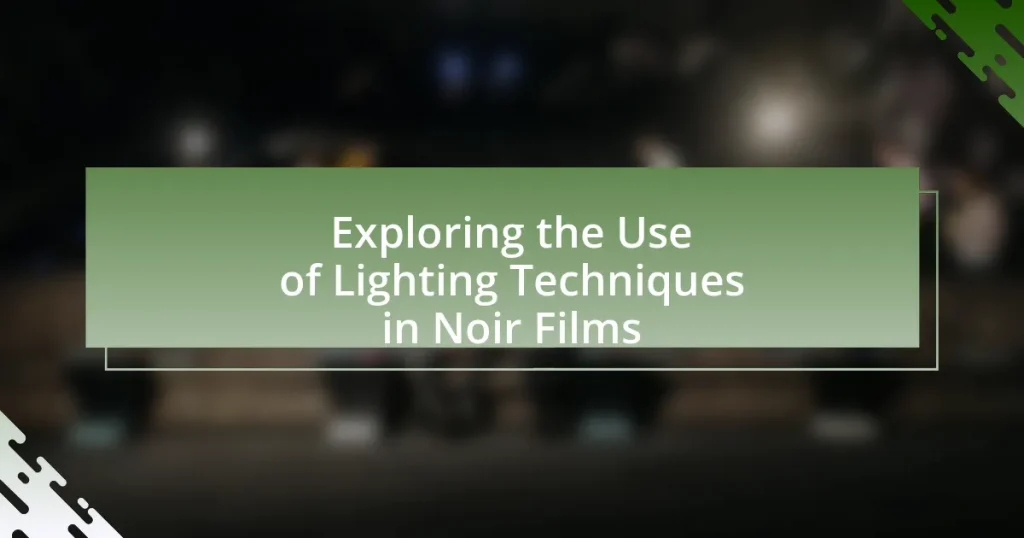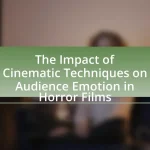The article explores the use of lighting techniques in noir films, emphasizing the significance of high-contrast and low-key illumination in creating a moody atmosphere that enhances themes of mystery and moral ambiguity. It discusses specific lighting styles, such as chiaroscuro, and their role in character development and audience perception. Historical contexts, technological advancements, and modern adaptations of these techniques are examined, highlighting how filmmakers balance artistic vision with practical constraints. The article also identifies common mistakes to avoid and best practices for effectively utilizing lighting in noir cinema.
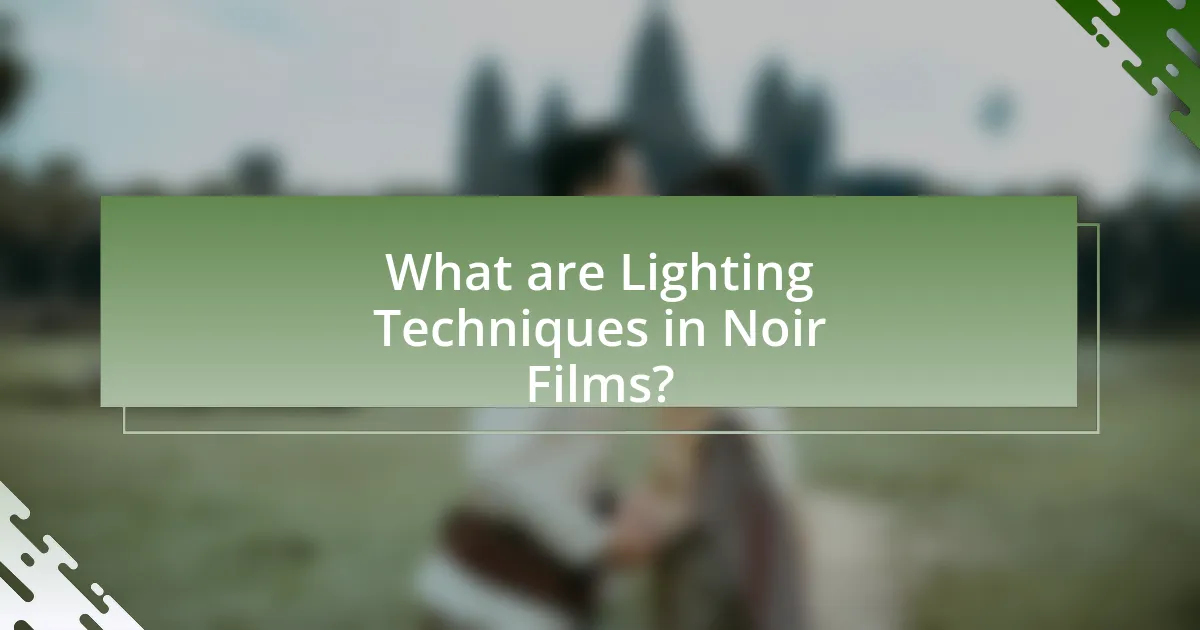
What are Lighting Techniques in Noir Films?
Lighting techniques in noir films primarily involve high-contrast lighting, often characterized by low-key illumination and dramatic shadows. This approach creates a moody atmosphere that enhances themes of mystery and moral ambiguity, which are central to the genre. For instance, the use of chiaroscuro lighting, where stark contrasts between light and dark are employed, emphasizes the psychological tension and complexity of characters. Classic examples include films like “Double Indemnity” and “The Maltese Falcon,” where lighting not only sets the tone but also visually represents the characters’ inner conflicts and the overarching themes of deception and danger.
How do lighting techniques contribute to the overall aesthetic of noir films?
Lighting techniques significantly contribute to the overall aesthetic of noir films by creating stark contrasts and deep shadows that enhance the mood and atmosphere. These techniques, such as low-key lighting, emphasize the themes of moral ambiguity and psychological tension prevalent in noir narratives. For instance, the use of chiaroscuro lighting, which juxtaposes light and dark, visually represents the internal conflicts of characters, often highlighting their duality and complexity. Historical examples include films like “Double Indemnity” and “The Maltese Falcon,” where lighting not only sets the tone but also guides the audience’s emotional response, reinforcing the genre’s signature style.
What specific lighting styles are commonly used in noir films?
Noir films commonly utilize low-key lighting, which creates stark contrasts between light and shadow, enhancing the mood of mystery and tension. This style often employs hard light sources to cast deep shadows, emphasizing the psychological complexity of characters and their moral ambiguity. Additionally, chiaroscuro lighting is frequently used, where the interplay of light and dark highlights the dramatic elements of the narrative, reinforcing themes of duality and conflict. Historical examples include films like “Double Indemnity” and “The Maltese Falcon,” which exemplify these lighting techniques to evoke a sense of foreboding and intrigue.
How does chiaroscuro lighting enhance the mood in noir narratives?
Chiaroscuro lighting enhances the mood in noir narratives by creating stark contrasts between light and shadow, which evokes feelings of tension and mystery. This technique emphasizes the moral ambiguity of characters and situations, often highlighting their inner conflicts and darker motivations. For instance, the use of deep shadows can obscure a character’s face, suggesting hidden intentions or secrets, while pools of light can draw attention to critical elements, such as a weapon or a revealing expression. The historical context of film noir, particularly during the 1940s and 1950s, showcases how directors like Orson Welles and Billy Wilder employed chiaroscuro to reinforce themes of paranoia and existential dread, making the visual style integral to the storytelling.
Why is lighting considered a critical element in noir filmmaking?
Lighting is considered a critical element in noir filmmaking because it establishes mood, enhances visual storytelling, and creates a sense of tension and ambiguity. In noir films, low-key lighting is often employed to cast deep shadows and highlight contrasts, which reflects the moral complexities and psychological states of characters. This technique not only contributes to the film’s aesthetic but also reinforces themes of crime, betrayal, and existential dread, as seen in classics like “Double Indemnity” and “The Maltese Falcon.” The use of chiaroscuro lighting effectively symbolizes the duality of human nature, making it an essential tool for conveying the narrative’s darker undertones.
What role does lighting play in character development within noir films?
Lighting plays a crucial role in character development within noir films by visually representing the psychological states and moral complexities of characters. High-contrast lighting, often characterized by deep shadows and stark highlights, creates a sense of tension and ambiguity, reflecting the inner turmoil and duality of characters such as the morally ambiguous detective or the femme fatale. For instance, the use of chiaroscuro lighting not only enhances the visual aesthetic but also symbolizes the characters’ struggles between good and evil, as seen in films like “Double Indemnity” and “The Maltese Falcon.” This technique effectively communicates character motivations and emotional depth, making lighting an essential tool in the storytelling of noir cinema.
How does lighting influence the audience’s perception of the story?
Lighting significantly influences the audience’s perception of the story by shaping mood, highlighting themes, and guiding emotional responses. In noir films, low-key lighting creates stark contrasts and shadows, which evoke feelings of tension and uncertainty, aligning with the genre’s themes of moral ambiguity and existential dread. For instance, the use of chiaroscuro lighting not only enhances the visual aesthetic but also symbolizes the internal conflicts of characters, reinforcing the narrative’s complexity. Studies have shown that specific lighting techniques can alter viewers’ emotional engagement; for example, research published in the Journal of Media Psychology indicates that dim lighting can increase feelings of suspense and anxiety, thereby deepening the audience’s connection to the story.
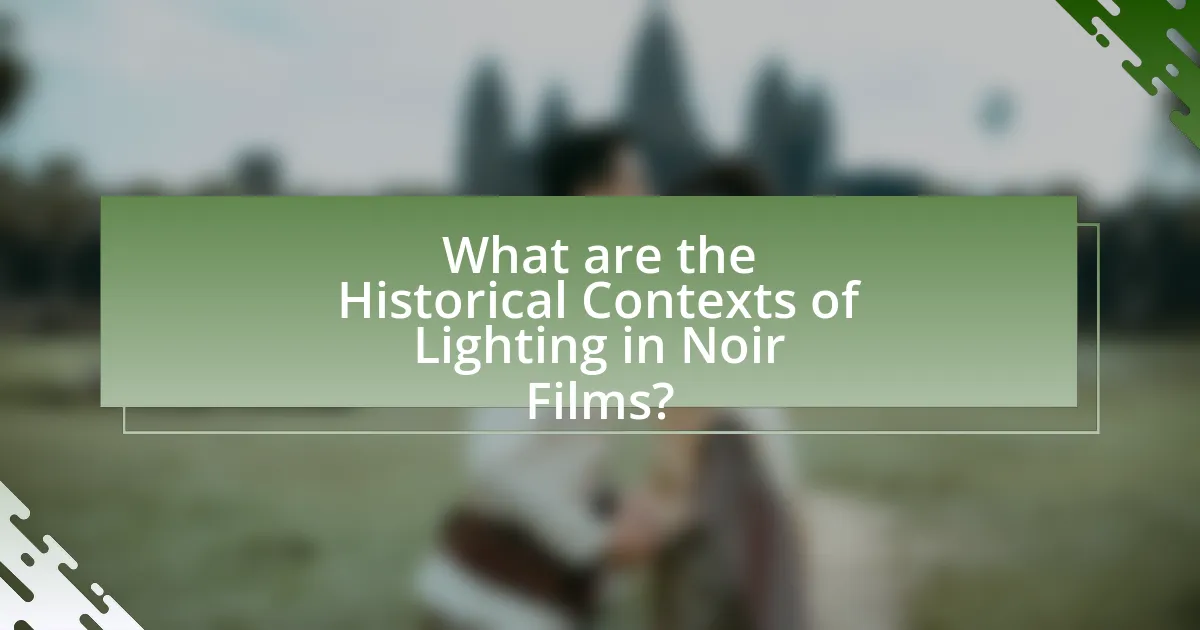
What are the Historical Contexts of Lighting in Noir Films?
The historical contexts of lighting in noir films are rooted in the cinematic techniques developed during the 1940s and 1950s, influenced by German Expressionism and the socio-political climate of post-World War II America. Noir films utilized low-key lighting to create stark contrasts and deep shadows, reflecting themes of moral ambiguity and existential despair prevalent in the era. The use of chiaroscuro lighting, characterized by dramatic illumination and shadow, was a hallmark of this genre, enhancing the psychological tension and visual style. This approach was further solidified by filmmakers like Orson Welles in “Citizen Kane” and John Huston in “The Maltese Falcon,” who employed innovative lighting techniques to evoke mood and character depth, establishing a visual language that defined film noir.
How did the film noir movement influence lighting techniques?
The film noir movement significantly influenced lighting techniques by popularizing high-contrast, low-key lighting that created dramatic shadows and emphasized the psychological states of characters. This style, characterized by stark lighting contrasts and deep shadows, was used to evoke a sense of mystery and tension, aligning with the themes of moral ambiguity and existential dread prevalent in noir narratives. Cinematographers like John Alton and Gregg Toland employed techniques such as chiaroscuro lighting to enhance the visual storytelling, making shadows an integral part of the composition. The use of these lighting techniques became a hallmark of the genre, influencing subsequent cinematic styles and practices in both film and television.
What historical events shaped the use of lighting in early noir films?
The use of lighting in early noir films was significantly shaped by the rise of German Expressionism in the 1920s, particularly through films like “The Cabinet of Dr. Caligari,” which utilized stark contrasts and shadows to evoke psychological tension. This movement influenced American filmmakers, who adopted similar techniques to create the moody, atmospheric visuals characteristic of film noir. Additionally, the impact of World War II and the subsequent societal disillusionment led to darker themes and visual styles in cinema, further emphasizing the use of low-key lighting and chiaroscuro effects to reflect the moral ambiguity and complexity of the characters. The combination of these historical events established a visual language that defined early noir films.
How did technological advancements impact lighting in noir cinema?
Technological advancements significantly impacted lighting in noir cinema by enabling more sophisticated and expressive lighting techniques. Innovations such as the introduction of portable lighting equipment and the use of low-key lighting allowed filmmakers to create the stark contrasts and deep shadows characteristic of the genre. For instance, the development of film stocks that were more sensitive to light permitted shooting in lower light conditions, enhancing the moody atmosphere essential to noir. Additionally, advancements in lighting control, such as dimmers and reflectors, facilitated the manipulation of light to achieve the dramatic effects that define noir aesthetics. These technological improvements not only shaped the visual style of noir films but also influenced the storytelling by emphasizing themes of moral ambiguity and psychological tension.
What are the key characteristics of noir lighting styles?
Noir lighting styles are characterized by high contrast, dramatic shadows, and a moody atmosphere. These elements create a sense of tension and unease, often using low-key lighting to emphasize the psychological states of characters. The use of chiaroscuro, where light and dark are juxtaposed, enhances the visual storytelling, making the environment feel oppressive and mysterious. This style is rooted in the visual aesthetics of film noir from the 1940s and 1950s, where filmmakers like Billy Wilder and Orson Welles employed these techniques to evoke emotions and highlight moral ambiguity.
How does low-key lighting create tension in noir films?
Low-key lighting creates tension in noir films by emphasizing shadows and contrasts, which evoke a sense of mystery and unease. This lighting technique often results in stark illumination of characters against dark backgrounds, highlighting their emotional states and moral ambiguity. For instance, the use of chiaroscuro—where light and dark are juxtaposed—intensifies the psychological conflict within the narrative, making viewers feel the suspense and danger inherent in the story. Historical examples include films like “Double Indemnity” and “The Maltese Falcon,” where low-key lighting effectively enhances the film’s themes of betrayal and deception, reinforcing the tension throughout the plot.
What is the significance of shadows in noir cinematography?
Shadows in noir cinematography are significant as they create a sense of mystery and tension, enhancing the film’s emotional depth. The use of stark contrasts between light and dark, known as chiaroscuro, emphasizes the moral ambiguity of characters and situations, often reflecting their inner turmoil. This technique is exemplified in classic films like “Double Indemnity” and “The Maltese Falcon,” where shadows not only serve aesthetic purposes but also symbolize the characters’ psychological states and the themes of deception and danger. The pervasive use of shadows in these films reinforces the genre’s characteristic atmosphere, making it a defining element of noir cinematography.
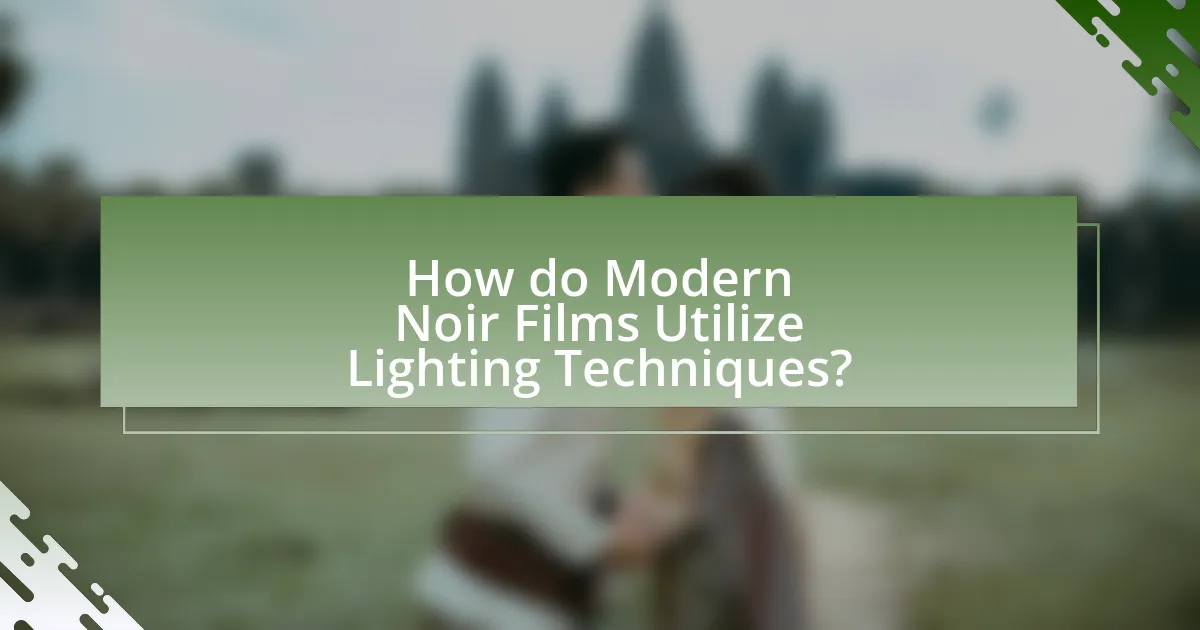
How do Modern Noir Films Utilize Lighting Techniques?
Modern noir films utilize lighting techniques to create a distinct atmosphere characterized by high contrast and shadow play. These films often employ low-key lighting to emphasize the moral ambiguity of characters and settings, enhancing the psychological tension inherent in the narrative. For instance, the use of chiaroscuro lighting, which contrasts light and dark areas, is prevalent in modern noir to evoke feelings of unease and suspense. This technique draws from classic noir traditions, where filmmakers like Orson Welles and Billy Wilder used similar methods to convey complex emotional states. The strategic placement of light sources, such as backlighting and practical lights, further accentuates the themes of isolation and danger, reinforcing the genre’s signature aesthetic.
What contemporary films exemplify the use of classic noir lighting techniques?
Contemporary films that exemplify the use of classic noir lighting techniques include “Blade Runner 2049,” “Sin City,” and “The Black Dahlia.” “Blade Runner 2049” employs high-contrast lighting and deep shadows reminiscent of classic film noir, enhancing its themes of isolation and moral ambiguity. “Sin City” utilizes stark black-and-white visuals with splashes of color, echoing the visual style of noir comics and films. “The Black Dahlia” incorporates chiaroscuro lighting to create a sense of mystery and tension, aligning with traditional noir aesthetics. These films effectively demonstrate how classic noir lighting techniques can be adapted to modern storytelling.
How do modern filmmakers adapt traditional lighting styles for new narratives?
Modern filmmakers adapt traditional lighting styles by incorporating high-contrast techniques and chiaroscuro effects to enhance emotional depth and narrative tension. For instance, they utilize low-key lighting, a hallmark of classic noir, to create shadows that evoke mystery and suspense, while also integrating contemporary technology such as LED lighting for greater control and versatility. This blend allows filmmakers to maintain the atmospheric qualities of traditional noir while tailoring the visual experience to modern storytelling needs, as seen in films like “Sin City” and “Blade Runner 2049,” which pay homage to noir aesthetics while exploring new themes and narratives.
What innovations in lighting technology are being used in modern noir films?
Modern noir films utilize innovations in lighting technology such as LED lighting, digital color grading, and advanced lighting control systems. LED lighting allows for greater flexibility and efficiency, enabling filmmakers to create dramatic contrasts and shadows characteristic of the noir style while reducing energy consumption. Digital color grading enhances the visual aesthetic by allowing precise manipulation of color tones and contrasts in post-production, which is essential for achieving the moody atmosphere typical of noir. Advanced lighting control systems, including remote-controlled lighting rigs, enable dynamic adjustments during shooting, facilitating complex lighting setups that enhance the narrative tension and visual storytelling inherent in modern noir films.
What are the challenges of using lighting in noir films today?
The challenges of using lighting in noir films today include balancing modern visual aesthetics with traditional noir techniques. Contemporary filmmakers often face the pressure to adapt to high-definition formats that can expose flaws in lighting choices, making it difficult to achieve the desired shadowy, moody atmosphere characteristic of classic noir. Additionally, the prevalence of digital cinematography has shifted the approach to lighting, as filmmakers must navigate the differences in how light interacts with digital sensors compared to film. This transition can dilute the stark contrasts and deep shadows that define the noir style, leading to a potential loss of the genre’s signature visual tension.
How do filmmakers balance artistic vision with practical lighting constraints?
Filmmakers balance artistic vision with practical lighting constraints by employing a combination of creative problem-solving and technical expertise. They often utilize tools such as adjustable lighting equipment, gels, and reflectors to manipulate light while adhering to budgetary and spatial limitations. For instance, in noir films, filmmakers frequently use high-contrast lighting to create mood, which can be achieved with minimal setups by strategically placing lights and using shadows effectively. This approach allows them to maintain their artistic intent while working within the confines of their production resources.
What common mistakes should filmmakers avoid when using lighting in noir films?
Filmmakers should avoid overexposure when using lighting in noir films, as it undermines the genre’s characteristic shadows and contrasts. Noir relies heavily on low-key lighting to create mood and tension; excessive brightness can flatten the visual depth and eliminate the dramatic effect essential to the style. Additionally, filmmakers should not neglect the importance of practical lights, as they enhance realism and contribute to the atmospheric quality typical of noir. Lastly, failing to consider the direction of light can lead to unintentional highlights that disrupt the intended chiaroscuro effect, which is crucial for establishing the film’s tone and visual storytelling.
What are best practices for effectively using lighting in noir films?
Best practices for effectively using lighting in noir films include employing high-contrast lighting to create dramatic shadows and emphasizing chiaroscuro effects to enhance the mood. This technique is essential in establishing the film’s dark and mysterious atmosphere, which is a hallmark of the noir genre. For instance, the use of low-key lighting can accentuate characters’ features and create a sense of tension, as seen in classic films like “Double Indemnity” and “The Maltese Falcon.” Additionally, strategic use of practical lights, such as lamps or streetlights, can add realism while contributing to the overall aesthetic. These practices are supported by the historical context of film noir, which emerged in the 1940s and 1950s, where lighting played a crucial role in storytelling and visual style.
